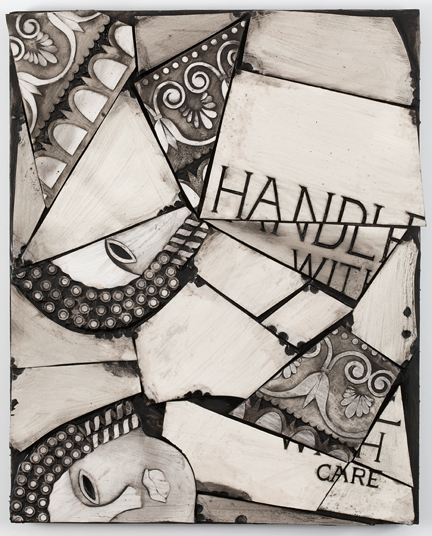
 |
|||||
|
(The following is
a conversation between Talia Chetrit and Ruby Sky Stiler. After I interviewed Talia for this site, I demanded that she
take on the role of interviewer and begin a series of Q and A sessions leading God knows where. Now it's Ruby's time
for the spotlight, and in turn, she will be forced to conduct an interview of her own. She will have no choice. I
will make her. Whomever Ruby interviews will be subject to this same treatment. And so on. Let's just see
what happens.) DECEMBER 2009
 Talia Chetrit: Hi Ruby! Your sculptures play with, examine
and push around ideas tied to collage whether it be the collage of time, the collapsing
of different historical time periods, or in the physical way you make your
work. Recently in your studio you
have been collaging the context in which you might expect to see the pieces,
mixing both recognizable art icons with more functional elements. Can you tell
me about this new approach? Ruby Sky Stiler: I find that question really offensive. Just
kidding! I have been really into this potential of creating an alternative
environment in which to experience the "artwork." In a recent show I
approached that idea by transforming the gallery into an interpretation of an
"attic" by installing long, distressed wooden floorboards and raising
the floor itself to limit the headspace of the room. I think this created a
viscerally disorienting feeling for people experiencing the space, because it
was a hot, cramped room with a creaky floor. While the gallery is oriented
towards the creation of value in an object, the attic is a realm where objects
go when they no longer have any use.
The more conventional artworks in the room were encouraged to shift
between these two states. I'm furthering that vein of interest by imagining
that the work I'm currently making in my studio is not intended for the gallery
but rather an overtly commercial realm of utilitarian objects, like a store.
I'm not proposing that these won't be viewed/discussed as artworks, but just
curious how that changes the way I go about my production. It's a suspension of
disbelief that I feel has the potential to make the work stranger and more
specific. It could consist of using materials that are not usually associated
with art or give the objects that I'm making an obvious purpose. I think that
creating an object with the gallery clearly in mind can have a conservatizing
effect on the work itself, I'm interested in perverting that. And it's pretty
fun.
TC: You challnge the value of art by changing the viewing
spaces where your work is shown, an attic or a store, and also by using
materials that are cheap and transforming them into what looks like ancient
priceless sculptures. Where does this interest in value come from? RSS: I don't know! Just shooting from the hip, though, I
grew up in New Mexico, immersed in New Age culture: Astrology, homeopathy, various
Native American traditions, Psychic readings, Buddhism, yoga... I always was
curious about the way that the community of adults I grew up with would move their
spiritual beliefs around and attach them to related talismans. Granting a deep,
spiritual, "magical" value to physical things. It's my feeling that
the value of a dream catcher or a prayer flag is pretty subjective, and relates
to the expectations of the person who's looking. (That said I don't feel
negative about the practice of piecing together ones own belief system at
all–just interested). In the past I've made work directly related to this
subject. Since then, the iconography has evolved and changed to include new and
different ideas, but the theme of objects and subjectivity has remained a part
of my work. Or maybe it's because I have no money.
TC: Can you tell me about your process and how you came to
this way of working? RSS: Well, you know, I absolutely MUST work naked. So,
that's a big part of my practice. OK fine, I wear clothes. Anyway, my work is
generally super process-oriented. At some point I noticed that my intelligence
comes more through a hands-on relationship to materials and their potential–than
through attempting to manifest some particular thesis. I really believe in
momentum, and things never get interesting when they are done in my head.
TC: Thanks for taking the time to answer some of my
questions! You’re amazing! Born in 1979, Ruby Sky Stiler lives and works in Brooklyn,
NY. She received her BFA from The Rhode Island School of Design and her MFA
from Yale University in 2006. Stiler's solo debut in New York at Nicelle
Beauchene Gallery was in May 2009. She has exhibited her work internationally,
including Sandroni Rey, Los Angeles; Kantor/Feuer Window, New York; DUMBO Arts
Center, Brooklyn; Annarumma, Naples, Italy; Guild & Greyshkul, New York;
Sunday Gallery, New York; China Art Objects, Los Angeles; and Allston Skirt Gallery,
Boston. Ruby is
represented by Nicelle Beauchene Gallery, nicellebeauchene.com
|
||||
|
|
||||